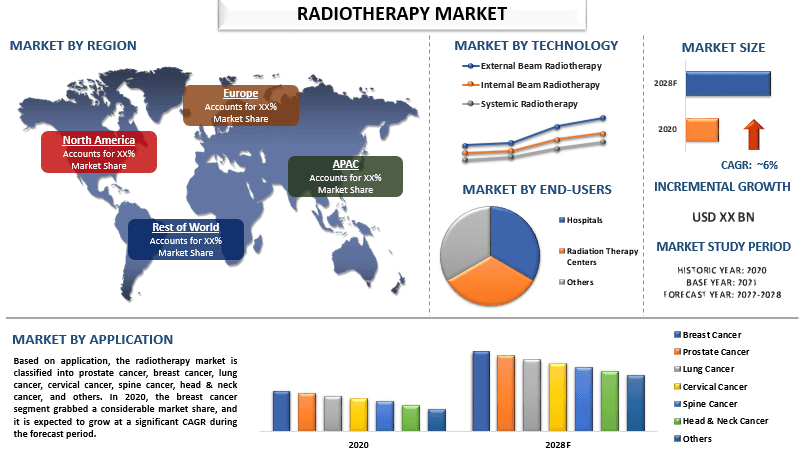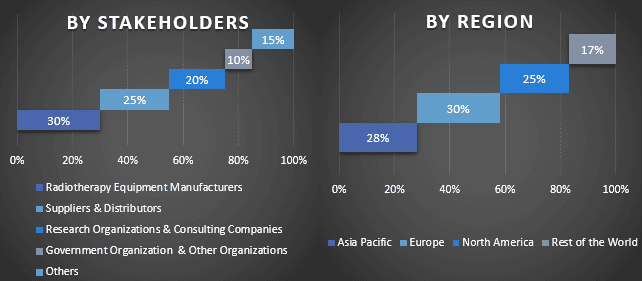- Startseite
- Über uns
- Industrie
- Dienstleistungen
- Lesen
- Kontaktieren Sie uns
Radiotherapie-Markt: Aktuelle Analyse und Prognose (2022-2028)
Schwerpunkt auf Technologie (Externe Strahlentherapie, Interne Strahlentherapie und Systemische Strahlentherapie); Anwendung (Prostatakrebs, Brustkrebs, Lungenkrebs, Gebärmutterhalskrebs, Wirbelsäulenkrebs, Kopf- und Halskrebs und Sonstige); Endnutzer (Krankenhäuser, Strahlentherapiezentren und Sonstige); und Region/Land

Es wird erwartet, dass der globale Markt für Strahlentherapie im Prognosezeitraum mit einer beträchtlichen Rate von etwa 6 % wachsen wird. Es wird erwartet, dass der globale Markt für Strahlentherapie aufgrund der zunehmenden Prävalenz verschiedener Krebsarten, der technologischen Fortschritte und der wachsenden Nachfrage nach nicht-invasiven Behandlungsoptionen für Krebs einen Aufschwung erleben wird. Darüber hinaus trägt der zunehmende Fokus der Forscher auf die Entwicklung einer wirksamen Krebsbehandlung, der zu einer Erhöhung der Ausgaben im Onkologiesektor führt, ebenfalls zum Wachstum des Marktes bei. Beispielsweise beliefen sich die globalen Ausgaben für Onkologie im Jahr 2020 auf insgesamt 167 Milliarden US-Dollar und werden bis 2022 voraussichtlich 206 Milliarden US-Dollar erreichen. Darüber hinaus wird erwartet, dass der Markt für Strahlentherapie aufgrund der zunehmenden Akzeptanz der Strahlentherapie, der technologischen Fortschritte und der beschleunigten FDA-Zulassungen für die Strahlentherapie wachsen wird. Beispielsweise erhielt das Strahlentherapiesystem Elekta Harmony im Sommer 2021 die FDA-Zulassung und wurde erstmals auf der Jahrestagung 2021 der American Society of Radiation Oncology (ASTRO) gezeigt. Dieses System bietet schnelle Behandlungen und die Möglichkeit, mehrere Metastasen gleichzeitig zu verfolgen und zu behandeln.
Siemens Healthineers AG, Accuray Incorporated, Elekta AB, Becton, Dickinson and Company, ViewRay Technologies Inc., Hitachi Ltd., IsoRay Inc., ZEISS Group, Mevion Medical Systems Inc., Panacea Medical Technologies Pvt. Ltd. sind einige der Hauptakteure auf dem Markt. Mehrere Fusionen und Übernahmen sowie Partnerschaften wurden von diesen Akteuren eingegangen, um Kunden mit Hightech- und innovativen Produkten/Technologien zu unterstützen.
Im Bericht dargestellte Erkenntnisse
„Unter den Technologien wird die Kategorie der externen Strahlentherapie im Prognosezeitraum einen höheren CAGR aufweisen“
Basierend auf der Technologie ist der Markt für Strahlentherapie in externe Strahlentherapie, interne Strahlentherapie und systemische Strahlentherapie unterteilt. Das Segment der externen Strahlentherapie machte im Jahr 2020 einen bedeutenden Marktanteil aus, und es wird geschätzt, dass es im prognostizierten Zeitraum schnell wachsen wird, da diese Technologie eine Genauigkeit der direkten Strahlen auf die Krebszellen bietet und so weniger Schäden an normalem Gewebe verursacht. Darüber hinaus ermöglicht es Onkologen auch, höhere Dosen der Strahlentherapie zur Behandlung zu verwenden, was auch das Marktwachstum antreibt.
„Unter den Anwendungen wird Brustkrebs im Jahr 2020 einen bedeutenden Anteil am Markt halten“
Basierend auf der Anwendung ist der Markt für Strahlentherapie in Prostatakrebs, Brustkrebs, Lungenkrebs, Gebärmutterhalskrebs, Wirbelsäulenkrebs, Kopf- und Halskrebs und andere unterteilt. Im Jahr 2020 eroberte das Segment Brustkrebs einen beträchtlichen Marktanteil, und es wird erwartet, dass es im Prognosezeitraum mit einer beträchtlichen CAGR wachsen wird, was auf den Anstieg der Inzidenz dieser Krebsart zurückzuführen ist. Laut der Weltgesundheitsorganisation gab es beispielsweise im Jahr 2020 fast 2,26 Millionen Fälle allein von Brustkrebs.
„Unter den Endverbrauchern werden Krankenhäuser im Jahr 2020 einen bedeutenden Anteil am Markt halten“
Basierend auf den Endverbrauchern ist der Markt in Krankenhäuser, Strahlentherapiezentren und andere unterteilt. Im Jahr 2020 eroberte das Krankenhaussegment einen beträchtlichen Marktanteil, und es wird erwartet, dass es im Prognosezeitraum mit einer beträchtlichen CAGR wachsen wird. Das Wachstum dieses Segments ist auf die wachsende Anzahl privater Krankenhäuser in verschiedenen Schwellenländern und die bessere Zugänglichkeit von Gesundheitsdiensten in Krankenhäusern zurückzuführen, was zu einer Zunahme der Präferenz von Patienten führt, sich in Krankenhäusern behandeln zu lassen.
„Nordamerika wird einen bedeutenden Anteil am Markt halten“
Für ein besseres Verständnis der Marktakzeptanz der Strahlentherapieindustrie wird der Markt basierend auf seiner weltweiten Präsenz in den Ländern wie Nordamerika (USA, Kanada, Rest von Nordamerika), Europa (Deutschland, Großbritannien, Frankreich, Spanien, Italien, Rest von Europa), Asien-Pazifik (China, Japan, Indien, Rest von Asien-Pazifik), Rest der Welt analysiert. Es wird erwartet, dass Nordamerika im Prognosezeitraum mit einer beträchtlichen CAGR wachsen wird. Die Hauptfaktoren wie günstige Regierungsinitiativen, erhöhte Investitionen in Forschung und Entwicklung für Strahlentherapie in Verbindung mit technologischen Fortschritten, der rasche Anstieg der älteren Bevölkerung und die steigende Anzahl von Krebsfällen treiben das Wachstum dieses Marktes in der Region an. Beispielsweise stieg die Zahl der Amerikaner ab 60 Jahren zwischen 2009 und 2019 um 34 % von 55,7 Millionen auf 74,6 Millionen.
Gründe für den Kauf dieses Berichts:
- Die Studie umfasst eine Analyse der Marktgröße und -prognose, die von authentifizierten wichtigen Branchenexperten validiert wurde.
- Der Bericht bietet einen schnellen Überblick über die Gesamtleistung der Branche auf einen Blick.
- Der Bericht enthält eine eingehende Analyse prominenter Branchenkollegen mit einem primären Fokus auf wichtige Finanzdaten, Produktportfolio, Expansionsstrategien und aktuelle Entwicklungen.
- Detaillierte Untersuchung von Treibern, Beschränkungen, wichtigen Trends und Chancen in der Branche.
- Die Studie deckt den Markt umfassend über verschiedene Segmente hinweg ab.
- Tiefgreifende regionale Analyse der Branche.
Anpassungsoptionen:
Der globale Markt für Strahlentherapie kann je nach Bedarf oder einem anderen Marktsegment weiter angepasst werden. Darüber hinaus versteht UMI, dass Sie möglicherweise Ihre eigenen geschäftlichen Anforderungen haben. Zögern Sie daher nicht, sich mit uns in Verbindung zu setzen, um einen Bericht zu erhalten, der Ihren Anforderungen vollständig entspricht.
Inhaltsverzeichnis
Forschungs-Methodik für die Radiotherapie-Marktanalyse (2022-2028)
Die Analyse des historischen Marktes, die Schätzung des aktuellen Marktes und die Prognose des zukünftigen Marktes des globalen Radiotherapie-Marktes waren die drei Hauptschritte, die unternommen wurden, um die Akzeptanz der Radiotherapie in den wichtigsten Regionen weltweit zu erstellen und zu analysieren. Es wurden umfassende Sekundärrecherchen durchgeführt, um die historischen Marktzahlen zu erfassen und die aktuelle Marktgröße zu schätzen. Zweitens wurden zahlreiche Erkenntnisse und Annahmen berücksichtigt, um diese Erkenntnisse zu validieren. Darüber hinaus wurden umfassende Primärinterviews mit Branchenexperten entlang der Wertschöpfungskette des globalen Radiotherapie-Marktes geführt. Nach der Annahme und Validierung der Marktzahlen durch Primärinterviews verwendeten wir einen Top-Down/Bottom-Up-Ansatz, um die vollständige Marktgröße zu prognostizieren. Danach wurden Methoden zur Marktaufschlüsselung und Datentriangulation angewendet, um die Marktgröße von Segmenten und Subsegmenten der betreffenden Branche zu schätzen und zu analysieren. Die detaillierte Methodik wird im Folgenden erläutert:
Analyse der historischen Marktgröße
Schritt 1: Eingehende Untersuchung von Sekundärquellen:
Es wurde eine detaillierte Sekundärstudie durchgeführt, um die historische Marktgröße des Radiotherapie-Marktes durch unternehmensinterne Quellen wie Jahresberichte und Finanzberichte, Leistungspräsentationen, Pressemitteilungen usw. und externe Quellen wie Fachzeitschriften, Nachrichten und Artikel, Regierungsveröffentlichungen, Wettbewerbsveröffentlichungen, Sektorberichte, Datenbanken von Drittanbietern und andere glaubwürdige Veröffentlichungen zu erhalten.
Schritt 2: Marktsegmentierung:
Nachdem wir die historische Marktgröße des Radiotherapie-Marktes erhalten hatten, führten wir eine detaillierte Sekundäranalyse durch, um historische Markteinblicke und -anteile für verschiedene Segmente und Subsegmente für wichtige Regionen zu sammeln. Die wichtigsten Segmente, die in dem Bericht enthalten sind, sind Technologie, Anwendung und Endverbraucher. Weiterhin wurden Länderanalysen durchgeführt, um die allgemeine Akzeptanz von Testmodellen in dieser Region zu bewerten.
Schritt 3: Faktorenanalyse:
Nachdem wir die historische Marktgröße der verschiedenen Segmente und Subsegmente ermittelt hatten, führten wir eine detaillierte Faktorenanalyse durch, um die aktuelle Marktgröße des Radiotherapie-Marktes zu schätzen. Darüber hinaus führten wir eine Faktorenanalyse unter Verwendung abhängiger und unabhängiger Variablen wie verschiedener Technologien, Anwendungen und Endverbraucher der Strahlentherapie durch. Es wurde eine gründliche Analyse der Angebots- und Nachfrageszenarien unter Berücksichtigung der wichtigsten Partnerschaften, Fusionen und Übernahmen, Geschäftsausweitungen und Produkteinführungen im Radiotherapie-Marktsektor weltweit durchgeführt.
Aktuelle Marktzöße Schätzung & Prognose
Aktuelle Marktgrößenbestimmung: Basierend auf den verwertbaren Erkenntnissen aus den oben genannten 3 Schritten ermittelten wir die aktuelle Marktgröße, die wichtigsten Akteure auf dem globalen Radiotherapie-Markt und die Marktanteile der Segmente. Alle erforderlichen prozentualen Anteile und Marktaufschlüsselungen wurden unter Verwendung des oben genannten sekundären Ansatzes ermittelt und durch Primärinterviews verifiziert.
Schätzung & Prognose: Für die Marktschätzung und -prognose wurden verschiedenen Faktoren Gewichte zugewiesen, darunter Triebkräfte & Trends, Hemmnisse und Chancen, die den Stakeholdern zur Verfügung stehen. Nach der Analyse dieser Faktoren wurden relevante Prognosetechniken, d. h. der Top-Down/Bottom-Up-Ansatz, angewendet, um die Marktprognose für 2028 für verschiedene Segmente und Subsegmente in den wichtigsten Märkten weltweit zu erstellen. Die Forschungsmethodik, die zur Schätzung der Marktgröße angewendet wurde, umfasst:
- Die Marktgröße der Branche in Bezug auf den Umsatz (USD) und die Akzeptanzrate des Radiotherapie-Marktes in den wichtigsten Märkten im Inland
- Alle prozentualen Anteile, Aufteilungen und Aufschlüsselungen von Marktsegmenten und Subsegmenten
- Die wichtigsten Akteure auf dem globalen Radiotherapie-Markt in Bezug auf die angebotenen Produkte. Außerdem die von diesen Akteuren angewandten Wachstumsstrategien, um im schnell wachsenden Markt wettbewerbsfähig zu sein
Validierung der Marktgröße und des Marktanteils
Primärforschung: Es wurden ausführliche Interviews mit den wichtigsten Meinungsführern (Key Opinion Leaders, KOLs) geführt, darunter Führungskräfte der obersten Ebene (CXO/VPs, Vertriebsleiter, Marketingleiter, Betriebsleiter, Regionalleiter, Länderleiter usw.) in den wichtigsten Regionen. Die Ergebnisse der Primärforschung wurden dann zusammengefasst, und es wurde eine statistische Analyse durchgeführt, um die aufgestellte Hypothese zu beweisen. Die Erkenntnisse aus der Primärforschung wurden mit den sekundären Erkenntnissen zusammengeführt, wodurch Informationen in verwertbare Erkenntnisse umgewandelt wurden.
Aufteilung der primären Teilnehmer in verschiedene Regionen

Markttechnik
Die Datentriangulationstechnik wurde angewendet, um die allgemeine Marktschätzung abzuschließen und genaue statistische Zahlen für jedes Segment und Subsegment des globalen Radiotherapie-Marktes zu erhalten. Die Daten wurden in mehrere Segmente und Subsegmente aufgeteilt, nachdem verschiedene Parameter und Trends in den Bereichen Technologie, Anwendung und Endverbraucher auf dem globalen Radiotherapie-Markt untersucht worden waren.
Das Hauptziel der globalen Radiotherapie-Marktstudie
Die aktuellen und zukünftigen Markttrends des globalen Radiotherapie-Marktes wurden in der Studie genau bestimmt. Investoren können strategische Einblicke gewinnen, um ihre Entscheidungen für Investitionen auf der Grundlage der in der Studie durchgeführten qualitativen und quantitativen Analyse zu treffen. Aktuelle und zukünftige Markttrends bestimmten die Gesamtattraktivität des Marktes auf regionaler Ebene und bieten dem Industrieteilnehmer eine Plattform, um den unerschlossenen Markt auszuschöpfen und von einem First-Mover-Vorteil zu profitieren. Weitere quantitative Ziele der Studien sind:
- Analyse der aktuellen und prognostizierten Marktgröße des Radiotherapie-Marktes in Bezug auf den Wert (USD). Analysieren Sie auch die aktuelle und prognostizierte Marktgröße verschiedener Segmente und Subsegmente
- Zu den Segmenten in der Studie gehören die Bereiche Technologie, Anwendung und Endverbraucher.
- Definition und Analyse des regulatorischen Rahmens für die Strahlentherapie
- Analyse der Wertschöpfungskette mit der Präsenz verschiedener Intermediäre sowie Analyse des Kunden- und Wettbewerbsverhaltens der Branche.
- Analyse der aktuellen und prognostizierten Marktgröße des Radiotherapie-Marktes für die wichtigsten Regionen.
- Zu den wichtigsten Ländern der in dem Bericht untersuchten Regionen gehören der asiatisch-pazifische Raum, Europa, Nordamerika und der Rest der Welt.
- Unternehmensprofile des Radiotherapie-Marktes und die von den Marktteilnehmern angewandten Wachstumsstrategien, um sich in dem schnell wachsenden Markt zu behaupten
- Tiefgehende Analyse der Branche auf regionaler Ebene
Verwandt Berichte
Kunden, die diesen Artikel gekauft haben, kauften auch










